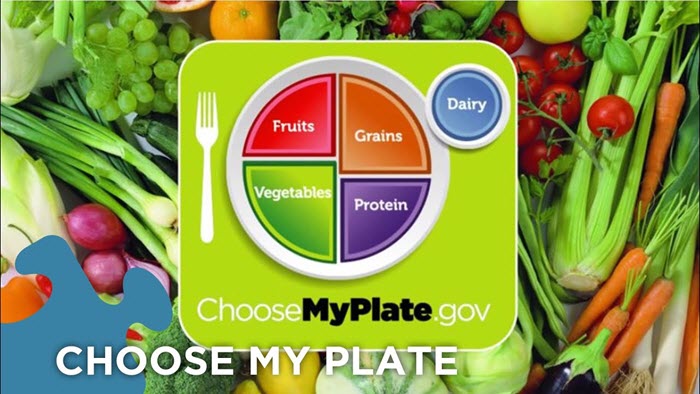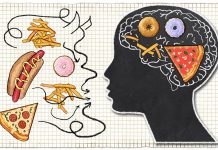
There are all sorts of diets out there that different people recommend for older adults. Many of these diets – most of which are sanctioned by the US government – address specific issues like high blood pressure, heart health, and sound nutrition. But is there one diet to rule them all? Or are all of these diets missing the point? Read on to learn more about them and find out the answer!
MyPlate

Remember the old Food Pyramid from the 90’s? MyPlate replaced it back in 2011. But they changed the macronutrient suggestions a bit in addition to giving the federal nutritional guideline infographic a makeover. It now suggests that 30% of the real estate on your dinner (or lunch, or breakfast…) plate should be occupied by grains, 40% by veggies, 10% by fruits, and 20% by protein. And although all of those ratios already add up to 100%, a small daily serving of dairy is also recommended. Oils and fats aren’t discussed directly; rather, they’re divided into the healthy fats that already exist in protein, nuts, and veggies, and “oils” which are not present on the MyPlate plate at all.
Pros
- People are most familiar with the federal nutritional guidelines because they’ve been around for so long and preached to so many.
- It’s also the typical diet most people eat if they’re trying to lose weight by following a “calories in, calories out” formula.
Cons
- It provides a plethora of vague, general suggestions for healthier eating but comes up short on specific recommendations such as guidance on good fats and bad fats.
DASH Diet
DASH Stands for Dietary Approaches to Stop Hypertension. It places a strong emphasis on gradually lowering your daily sodium intake to 1,500 mg while consuming most of your calories from fruits, whole grains, veggies, lean protein, and low-fat dairy. Other food groups should be avoided or eaten in moderation.
Pros
- It was designed and promoted by the National Heart, Lung, and Blood Institute, a US government organization dedicated towards research and information on cardiovascular health
Cons
- It can be pricey
- People who struggle to lose weight with MyPlate may have similar troubles with DASH
- The low sodium intake could be dangerous for people with low blood pressure
TLC Diet
The Therapeutic Lifestyle Changes (TLC) diet is largely concerned with getting people’s cholesterol problems under control. This food plan revolves around a high intake of fruits and vegetables followed by cereals, breads, pasta, and lean meats. It is an extremely low fat diet, especially with regard to saturated fat.
Pros
- Comes with the US government stamp of approval as a “heart healthy” diet
- The abundance of low-fat options, lean meats, and well-stocked produce sections in most grocery stores makes shopping easy and affordable
Cons
- May also promote insulin resistance according to recent research
- It’s easy to gain weight on this diet if you don’t watch your fat intake very carefully
Mediterranean Diet
A closer look at the Mediterranean diet shows that it is actually quite similar to a MyPlate diet, with a few important differences. Olive oil is moved down the pyramid a few steps just above fruits and vegetables for its heart-healthy monounsaturated fat benefits. Just above that is a strong emphasis on fish and seafood intake for their heart healthy omega-3 fatty acids. Red meat and saturated fat are both strongly discouraged.
Pros
- You get to eat like an Italian everyday – it’s delicious!
- It has potentially superior heart health benefits compared to other diets
Cons
- Seafood can get expensive
- The lack of red meat may promote iron deficiencies
- The emphasis on carbohydrates may also promote insulin resistance
Low-Carb Diet
A healthy low-carb diet virtually eliminates breads, grains, legumes, and sugar-sweetened beverages from your diet. It replaces them with higher protein and higher fat intake, with less than 40 g of carbs per day coming only from fruits and/or vegetables. Ultra-processed food should be kept to a minimum or eliminated from the diet completely.
Pros
- Highly satiating
- People lose a lot of weight quickly in the beginning
- Leaves room for higher protein and dairy intake, which can help offset osteoporosis and muscle loss in older adults
- The combination of fewer carbs and more unsaturated fats is good for heart health
Cons
- The prevalence of high-carb foods outside of the home and the lack of low-carb options in social situations can make the diet difficult to stick with
And the Winner Is…
The truth is that there is no one diet that works best for everyone. Biologically, our bodies are too complex and there is too much genetic variation for that to be possible. We strongly suggest starting with the diets we’ve outlined here and seeing which one works best for you. Good luck, and happy eating!




















































